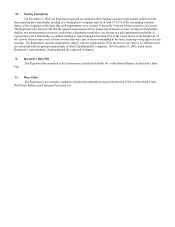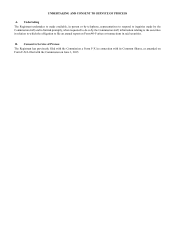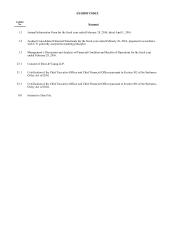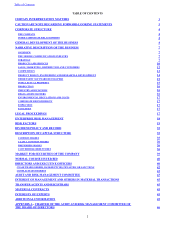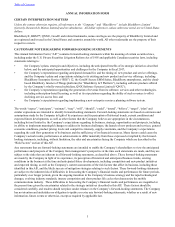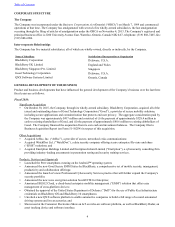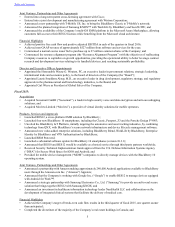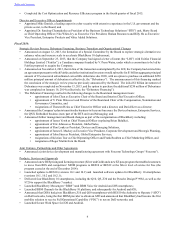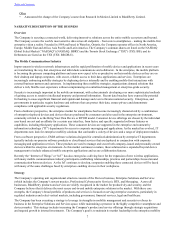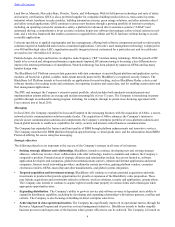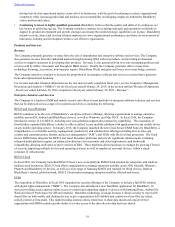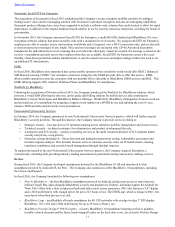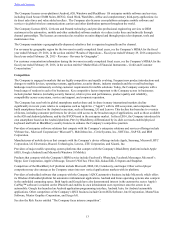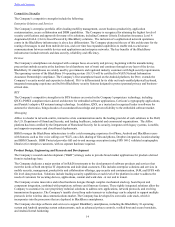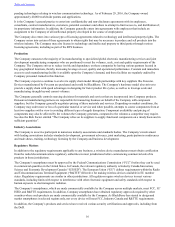Blackberry 2016 Annual Report Download - page 16
Download and view the complete annual report
Please find page 16 of the 2016 Blackberry annual report below. You can navigate through the pages in the report by either clicking on the pages listed below, or by using the keyword search tool below to find specific information within the annual report.
Table of Contents
7
Other
• Announced the change of the Company’s name from Research In Motion Limited to BlackBerry Limited.
NARRATIVE DESCRIPTION OF THE BUSINESS
Overview
The Company is securing a connected world, delivering innovative solutions across the entire mobile ecosystem and beyond.
The Company secures the world’s most sensitive data across all endpoints – from cars to smartphones – making the mobile-first
enterprise vision a reality. Founded in 1984 and based in Waterloo, Ontario, the Company operates offices in North America,
Europe, Middle East and Africa, Asia Pacific and Latin America. The Company’s common shares are listed on the NASDAQ
Global Select Market (“NASDAQ”) (NASDAQ: BBRY) and the Toronto Stock Exchange (“TSX”) (TSX: BB), and its
Debentures are listed on the TSX (TSX: BB.DB.U).
The Mobile Communications Industry
Improvements in wireless network infrastructure and the rapid proliferation of mobile devices and applications in recent years
are transforming the way that enterprises and individuals communicate and collaborate. In the enterprise, the mobile platform
is becoming the primary computing platform and users now expect to be as productive on their mobile devices as they are on
their desktop and laptop computers, with secure, reliable access to their data, applications and services. Enterprises are
increasingly embracing mobility strategies by deploying devices internally and by enabling mobile-first interactions with
external business partners and customers. In implementing these mobility strategies, organizations demand solutions that
deliver a rich, flexible user experience without compromising on centralized management or enterprise-grade security.
Security is increasingly important in the mobile environment, with cybercriminals developing ever more sophisticated methods
of gaining access to sensitive intellectual property and personal information. Recent data breaches have exposed the potential
for hacking to cause significant financial and reputational damage and even to threaten national security. Enterprises, and
governments in particular, require hardware and software that can protect their data, ensure privacy and demonstrate
compliance with applicable security regulations.
From a hardware perspective, the enterprise market for smartphones has become increasingly characterized by a combination
of enterprise-deployed devices and devices that are purchased by consumers and also used in the enterprise environment,
commonly referred to as the Bring Your Own Device or BYOD model. Consumer device offerings are chosen by the individual
user based on cost and an affinity for a certain user interface, form factor, and specific supported software features or
capabilities, including third-party applications. These consumer devices are supported in the enterprise environment by
information technology (“IT”) departments for access to corporate messaging and applications. As the market has evolved, IT
departments now look for enterprise mobility solutions that can handle a variety of devices and a range of deployment models.
From a software perspective, EMM software solutions designed for centralized administration by enterprise IT departments
typically include on-premise software products or cloud-based services that are deployed in conjunction with corporate
messaging and application services. These products are used to manage and secure both company-issued and personally-owned
devices within the enterprise environment. As this market continues to mature, these solutions have expanded beyond device
management to include enhanced mobile enterprise applications and secure collaboration features.
Recently the “Internet of Things” or “IoT” has also emerged as a driving force for the expansion of new wireless applications,
with many mobile communications industry participants establishing relationships, practices and partnerships focused around
communication between devices. As the IoT continues to develop, companies enabling these connected devices will be faced
with many of the same challanges faced by enterprises enabling devices in their workplaces.
Strategy
The Company’s operating unit organizational structure consists of the Devices business, Enterprise Solutions and Services
(which includes the Company’s newest practice, Professional Cybersecurity Services), BTS, and Messaging. Across all
businesses, BlackBerry products and services are widely recognized in the market for productivity and security, and the
Company believes that it delivers the most secure end-to-end mobile enterprise solutions in the market. With these core
strengths, the Company’s broad portfolio of products and services is focused on serving enterprise customers, particularly in
regulated industries and select vertical markets, including government, financial services, legal and healthcare.
The Company has been executing a strategy to leverage its strengths in mobility management and security to refocus its
business in the Enterprise Solutions and Services space, while maintaining a presence in the highly competitive smartphone and
devices market. This strategy includes increasing the Company’s product and service offerings through strategic acquisitions
and targeted growth in internal investments. The Company’s goal is to maintain its market leadership in the enterprise mobility


